Bonita |
||||||||||||||||||||||||||||||||||||||||||||||
 |
 |
|||||||||||||||||||||||||||||||||||||||||||||
Crochet vest with crochet square and lace pattern in DROPS Paris. Size: S - XXXL
DROPS 175-24 |
||||||||||||||||||||||||||||||||||||||||||||||
|
PATTERN: See diagrams A.1 to A.5. CROCHET INFO: At beginning of every round/row with trebles replace first treble on round/row with 3 chain stitches. At beginning of every round/row with double crochet work 1 chain stitch (does not replace first double crochet). INCREASE TIP: Increase 1 treble by working 2 trebles in same stitch. Increase 1 double treble by working 2 double trebles in same stitch. ---------------------------------------------------------- VEST: The vest is worked in 3 parts. Work back piece as a square separately. Work front pieces as a half circle and continue up to shoulder. When front pieces and back piece are sewn together, work 1 round with picots along entire outer edge. BACK PIECE: Begin with crochet hook size 5 mm and Paris and work pattern according to diagram A.2 4 times in total on round (A.1 shows how round begins and ends). REMEMBER THE CROCHET TENSION! When A.2 has been worked, there are 35 trebles along each side and 4 corners that consist of 2 trebles, 3 chain stitches and 2 trebles. The square for back piece is done for size S/M, fasten off. Crochet square measures approx. 28 x 28 cm. Continue in the round in size L/XL and XXL/XXXL as follows: L/XL: Repeat the last 2 rounds. Increase 1 treble before and after each corner. There are now 2 trebles more on each of the 4 sides = 39 trebles along each side. Fasten off. Crochet square measures approx. 37 x 37 cm. XXL/XXXL: Repeat the last 2 rounds. Increase 1 treble before and after each corner. There are now 2 trebles more on each of the 4 sides = 43 trebles along each side. Work slip stitches until chain space with 3 chain stitches in first corner. Then work from 2nd row in diagrams A.3A to A.3C back and forth along one side as follows: Work A.3A around this chain space (shows how row begins and ends) - READ CROCHET INFO. Work A.3B until 1 treble remains before chain space in next corner, work A.3C (= 1 chain stitch, skip 1 treble and work 1 treble around chain space in corner). Turn and work last row in diagrams. Fasten off. Work the same way along the side on opposite side of square. Fasten off. Crochet square measures approx. 47 x 37 cm. RIGHT FRONT PIECE: Work 4 chain stitches on hook size 5 mm with Paris and form a ring with 1 slip stitch in first chain stitch. Then work a half circle as follows: ROW 1: Work 4 chain stitches, * 1 treble around chain stitch ring, 1 chain stitch *, repeat from *-* 7 more times, finish with 1 treble around ring. Turn and work as follows from right side: Work A.4A, A.4B, A.4C. On last row in diagrams increase evenly as follows - READ INCREASE TIP: Increase 0-6-6 trebles over A.4A (= 27-33-33 trebles) and 0-9-9 double trebles over A.4B (= 30-39-39 double trebles). Increase 0-3-3 trebles before corner in A.4C (= 6-9-9 trebles) and increase 0-3-3 trebles after corner (= 13-16-16 trebles). there are 76-97-97 stitches in total + corner (= 2 trebles, 3 chain stitches, 2 trebles) on last row. Size S/M is now done, fasten off. Work back and forth in the 2 next sizes as follows: L/XL- XXL/XXXL: Turn and work from wrong side. Work from row marked with arrow in diagrams as follows: Work A.5B over the first 15 trebles, A.5A, 3 chain stitches, (2 trebles, 3 chain stitches, 2 trebles) around chain space in corner, 3 chain stitches, A.5B over the next 9 trebles, A.5C over the next 39 double trebles, A.5B over the next 32 trebles, finish with A.5A in the last treble on row. Work last row in diagrams the same way. There are now 97 trebles/double trebles + 1 corner (= 2 trebles, 3 chain stitches, 2 trebles) on last row. Fasten off. SHOULDER: Now work back and forth over the first trebles from right side in A.4 (in size S/M) and A.5 (in size L/XL and XXL/XXXL), begin from 2nd row in diagrams as follows: Work A.3A, A.3B 5-6-7 times in total in width. Turn and work last row. Repeat the 2 last rows in diagrams 3-3-4 more times. Fasten off. LEFT FRONT PIECE: Work as right front piece but reversed. ASSEMBLY: S/M and L/XL: Sew shoulder on to each side at the top edge on crochet square/back piece. Sew stitches together one by one. On back piece there are now 17-21 trebles for neck between shoulder pieces. Cut the yarn and fasten off. XXL/XXXL: Sew shoulder on to each side at the top edge on crochet square/back piece. Sew the 6 outermost treble crochets on shoulder to the side of the 2 outermost rows on back piece and sew the other stitches together one by one. On back piece there are now 25 trebles for neck between shoulder pieces. Cut the yarn and fasten off. PICOT EDGE: Begin on top of one shoulder and work a picot edge as follows: Work * 1 treble in treble/around row, 3 chain stitches, 1 slip stitches in first of the 3 chain stitches, 2 trebles in same treble/around row, skip approx. 2.5 cm *, repeat from *-* around the entire vest, i.e. around both armholes, along edge on front pieces, back of neck along bottom edge on back piece. Finish with a slip stitch in first treble on round. Fasten off. TWINED STRING: Cut 2 lengths of 1.5 metres each. Twine the strands tog until they resist, fold the string double so that it twines again. Make a knot at each end. Thread string through picot edge at the front on one front piece and tie a knot. Make another 3 strings the same way. Fasten one to the other front piece. Use the 2 other strands to keep front and back piece together in each side: Start approx. 21-23-25 cm from top of one of the front pieces and the back piece. Thread the string back and forth through holes in the picot edge, between the front and back piece in zig zags (like a shoe lace) and tie them together at the bottom - see picture. Adjust length on string so that distance between front piece and back piece is approx. 6-6-8 cm. Repeat in the other side. |
||||||||||||||||||||||||||||||||||||||||||||||
Diagram explanations |
||||||||||||||||||||||||||||||||||||||||||||||
|
||||||||||||||||||||||||||||||||||||||||||||||
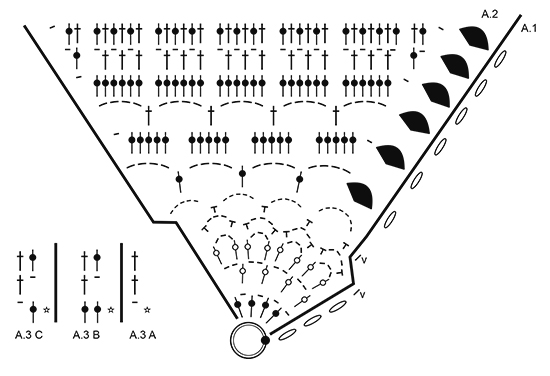
|
||||||||||||||||||||||||||||||||||||||||||||||
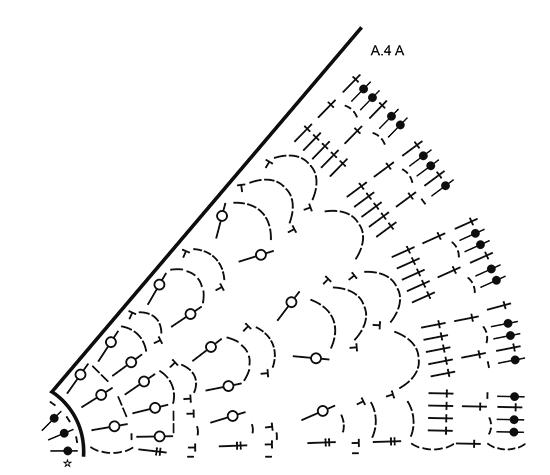
|
||||||||||||||||||||||||||||||||||||||||||||||

|
||||||||||||||||||||||||||||||||||||||||||||||

|
||||||||||||||||||||||||||||||||||||||||||||||

|
||||||||||||||||||||||||||||||||||||||||||||||
|
Have you made this or any other of our designs? Tag your pictures in social media with #dropsdesign so we can see them! Do you need help with this pattern?You'll find tutorial videos, a Comments/Questions area and more by visiting the pattern on garnstudio.com. © 1982-2024 DROPS Design A/S. We reserve all rights. This document, including all its sub-sections, has copyrights. Read more about what you can do with our patterns at the bottom of each pattern on our site. |
||||||||||||||||||||||||||||||||||||||||||||||








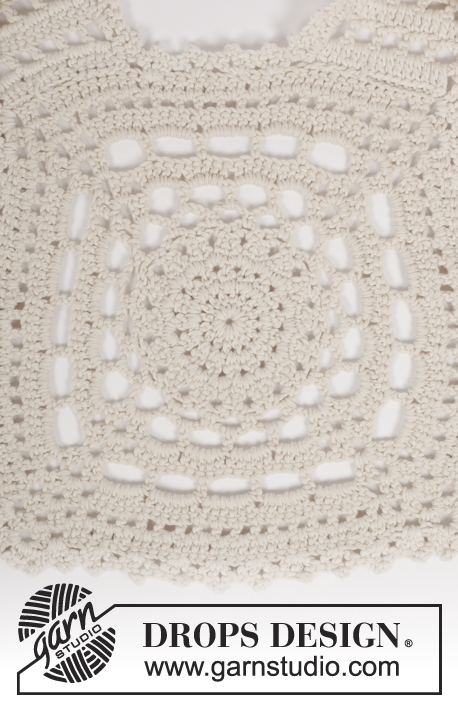

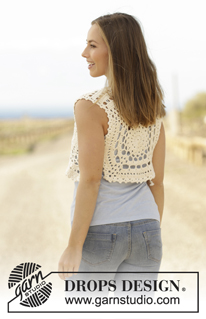
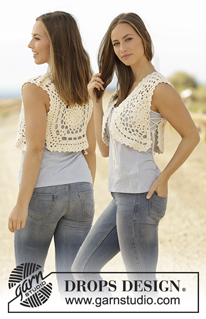























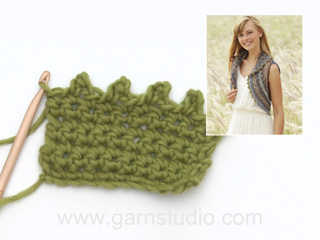



























Comments / Questions (41)
Thanks a lot for all your help.
25.05.2020 - 13:19Dear Drops! I need your help again, this time I don' t understand how to crochet shoulder. Should I work only A. 3A, A. 3B and what about A. 3C? My front piece ends with a corner 2tr3ch st2tr, then 3 ch and 13 tr to the end. And the 1st row in diagrams show 1ch st, 2 tr in chain space. Please, help me to solve this problem.
23.05.2020 - 21:57DROPS Design answered:
Dear Ekaterina, you should also start A.3 with A.3A and repeat A.3B over the last sts on the left side (end of rows from RS with A.4/A.5): count 5-6-7 times 2 sts (for each A.3B), then 1 more stitch for A.3A and start now with a.3A = 1 treble, and repeat A.3B (1 chain, skip 1 st, 1 treble). So that you have the correct number of sts: 11-13-15 sts. Happy crocheting!
25.05.2020 - 09:13If I crochet left front piece the same way as right front piece, I will need to turn it to have half circle look to the centre. But in this case last row will be done on the WS.
22.05.2020 - 11:06DROPS Design answered:
Dear Ekaterina, work the same way as on right front piece, then when crocheting shoulder, instead of working over the first stitches on the right side as for right front piece, you will now work over the last stitches on the left side (seen from RS). Happy crocheting!
22.05.2020 - 12:28Dear Drops! Would you be so kind to help me with the following problem. I failed to crochet left front piece. How should I begin? Could you explain the first rows, thanks in advance.
21.05.2020 - 01:38DROPS Design answered:
Dear Ekaterina, you start the same way but crochet then shoulder over the last stitches instead of the first stitches so that left front piece will be a mirrored image of the right front piece. Happy crocheting!
22.05.2020 - 09:07Hola, No me queda claro cómo hay que proceder para realizar los aumentos del frente derecho. Cuando se refiere "Aumentar 0-6-6 puntos altos sobre A.4A (= 27-33-33 puntos altos)". ¿Hay que hacer los aumentos en la última vuelta? ¿cuántos puntos (0-6-6)? Agradecería una explicación más concreta. Gracias.
14.05.2020 - 18:57DROPS Design answered:
Hola AlmySG, tu aumentas puntos en la última vuelta de los diagramas. Aumentar 0-6-6 puntos altos sobre A.4A depende de que talla haces (0 puntos en la talla S/M, 6 punos en las tallas L/XL y XXL/XXXL). Buen trabajo!
22.11.2020 - 20:17Dear Drops! What kind of yarn is used for the vest in the photo. It looks much thinner than Paris.
13.05.2020 - 22:47DROPS Design answered:
Dear Ekaterina, the modell was made with Paris yarn. Happy Crafting!
14.05.2020 - 01:39Ik mis telpatroon A1 en a2 van drops 175-24, deze zat niet bij het patroon en garen die ik besteld had, zou u de missende telpatroon alsnog kunnen sturen per mail, wil heel graag het mooie giletje haken. Groetjes Marjon
09.05.2020 - 17:56DROPS Design answered:
Dag Marjon,
Je kunt de telpatronen afdrukken via de afdrukknop bij het patroon op de site. Hier vind je de afbeeling van A.1 en A.2.
13.05.2020 - 10:08Re bonjour, Excusez moi, j'ai bien compris que les côtés doivent être symétriques, mais je ne comprends toujours pas ce que veut dire "en sens inverse" pour un diagramme en demi cercle. par quoi dois-je commencer ? cordialement
22.04.2020 - 16:53DROPS Design answered:
Bonjour Mme Plancher, vous crochetez le devant gauche comme le droit mais A.3 sera à gauche au lieu de à droite (vu sur l'endroit) pour que les deux demi-cercles soient symétriques et que les arrondis des demi-cercles soient face à face et l'épaule sur le côté "droit" du devant (= à droite sur le devant droit et à gauche sur le devant gauche). Bon crochet!
23.04.2020 - 10:19Bonjour, j'ai réalisé le dos sans problème mais j'ai beaucoup de mal à décortiquer les diagrammes du devant. j'obtiens quelque chose d'informe et petit avec un bord intérieur absolument pas droit. les A4 ne sont pas tout à fait à la même échelle. Y a-t-il des diagrammes plus clair ? ou un moyen d’enchainer les diagrammes que je n'ai pas compris . Pour le côté gauche que signifie "en sens inverse " ? Je démarre par quoi ? cordialement
22.04.2020 - 16:23DROPS Design answered:
Bonjour Mme Plancher, pour le devant droit, crochetez les diagrammes A.4A, A.4B,A.4C - vous devez avoir un demi-cercle (approx.). Crochetez ensuite quelques rangs supplémentaires avec A.5 si besoin. Pour former l'épaule: A.3A + 5 à 7 fois A.3B au-dessus du côté droit de A.4/A.5. Le devant gauche se fait en sens inverse pour que les 2 devants soient symétriques. (L'échelle des diagrammes ne change rien à la façon des les faire). En cas de doute, n'hésitez pas à montrer votre ouvrage à votre magasin - même une photo par mail - ce sera plus facile pour eux de pouvoir vous assister en voyant ce que vous avez fait. Bon crochet!
22.04.2020 - 16:43How do you work the left front side backwards? do you still work a4a, a4b and then a4c but from right to left or do you work a4c, a4b, a4a from left to right or vice versa? seems like whatever combination i use it just isnt possible? I dont understand why you make these patterns so difficult to follow, even for an expert!!
23.02.2020 - 00:11DROPS Design answered:
Dear Ashlee, you will work A.4 A, B & C the same way, but you will work the shoulders over the last stitches instead of the first stitches so that left front piece will be a mirrored image from the right front piece. Happy crocheting!
24.02.2020 - 08:51